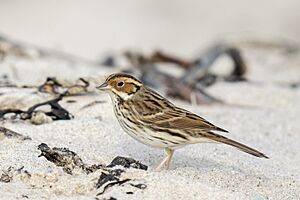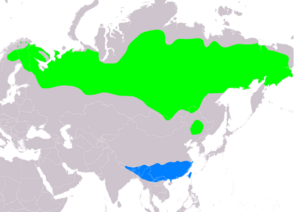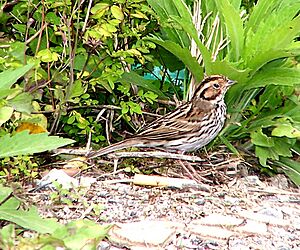Little bunting facts for kids
Quick facts for kids Little bunting |
|
|---|---|
 |
|
| On the island of Heligoland in the North Sea | |
| Conservation status | |
| Scientific classification | |
 |
|
| Range of E. pusilla Breeding Non-breeding |
The little bunting (scientific name: Emberiza pusilla) is a small songbird. It belongs to a group of birds called buntings. These birds are part of the passerine order, which includes many common songbirds.
Contents
What is a Little Bunting?
Its Scientific Name and Family
A scientist named Peter Simon Pallas first described the little bunting in 1776. This bird is a "monotypic" species. This means all little buntings look pretty much the same. They do not have different types or subspecies across their wide range.
The name Emberiza comes from an old German word, Embritz. This word was used for buntings. The second part of its scientific name, pusilla, is a Latin word. It means "very small," which fits this tiny bird perfectly.
What Does a Little Bunting Look Like?
Size and Markings
The little bunting is a small bird. It measures about 12 to 14 centimeters (5 to 5.5 inches) long. Its belly is white with dark stripes on its chest and sides.
Face and Head
Its face is a warm reddish-brown color. It has a white stripe near its beak, called a malar stripe. You can also spot black stripes on the top of its head. A clear white ring around its eye helps it stand out. There is also a thin dark line at the back of its reddish-brown cheeks.
Sounds and Calls
The little bunting has a special call that sounds like "zik." Its song is a rolling sound, often described as "siroo-sir-sir-siroo."
Where Do Little Buntings Live?
Habitat and Migration
Little buntings breed in the cold, northern forests called taiga. These forests are found in the far northeast of Europe and across northern Eurosiberia. They also live as far east as the Russian Far East.
These birds are migratory. This means they travel long distances for winter. They fly south to warmer places like northern India, southern China, and parts of Southeast Asia. They stay in these warm places for a long time.
Where They Are Found
Sometimes, a few little buntings might fly off course. They can be seen as rare visitors in western Europe. This bird can adapt to different places. For example, in the mountains of Bhutan, some little buntings spend the winter. They often live in agricultural areas, usually between 1,000 and 2,000 meters (3,300 to 6,600 feet) above sea level.
Life Cycle and Diet
Nesting and Eggs
Little buntings build their nests in open coniferous woodlands. They often choose areas where there are also birch or willow trees. A female little bunting usually lays four to six eggs in her tree nest.
What They Eat
Their main food is seeds. However, when they are feeding their young, they mostly eat insects. This helps their babies grow strong.
Conservation Status
The little bunting is a common bird. It lives across a very wide area. Because of this, it is not considered an endangered species. The IUCN Red List lists it as "Least Concern."



